Abstract
The Saccharomyces cerevisiae protein SEC14p is required for Golgi function and cell viability in vivo. This requirement is obviated by mutations that specifically inactivate the CDP-choline pathway for phosphatidylcholine biosynthesis. The biochemical basis for the in vivo relationship between SEC14p function and the CDP-choline pathway has remained obscure. We now report that SEC14p effects an in vivo depression of CDP-choline pathway activity by inhibiting choline-phosphate cytidylyltransferase (CCTase; EC 2.7.7.15), the rate-determining enzyme of the CDP-choline pathway. Moreover, this SEC14p-mediated inhibition of CCTase was recapitulated in vitro and was saturable. Finally, whereas the SEC14p-dependent inhibition of CCTase in vitro was markedly reduced under assay conditions that were expected to increase levels of phosphatidylinositol-bound SEC14p, assay conditions expected to increase levels of phosphatidylcholine-bound SEC14p resulted in significant potentiation of CCTase inhibition. The collective data suggest that the phosphatidylcholine-bound form of SEC14p effects an essential repression of CDP-choline pathway activity in Golgi membranes by inhibiting CCTase and that the phospholipid-binding/exchange activity of SEC14p represents a mechanism by which the regulatory activity of SEC14p is itself controlled.
Full text
PDF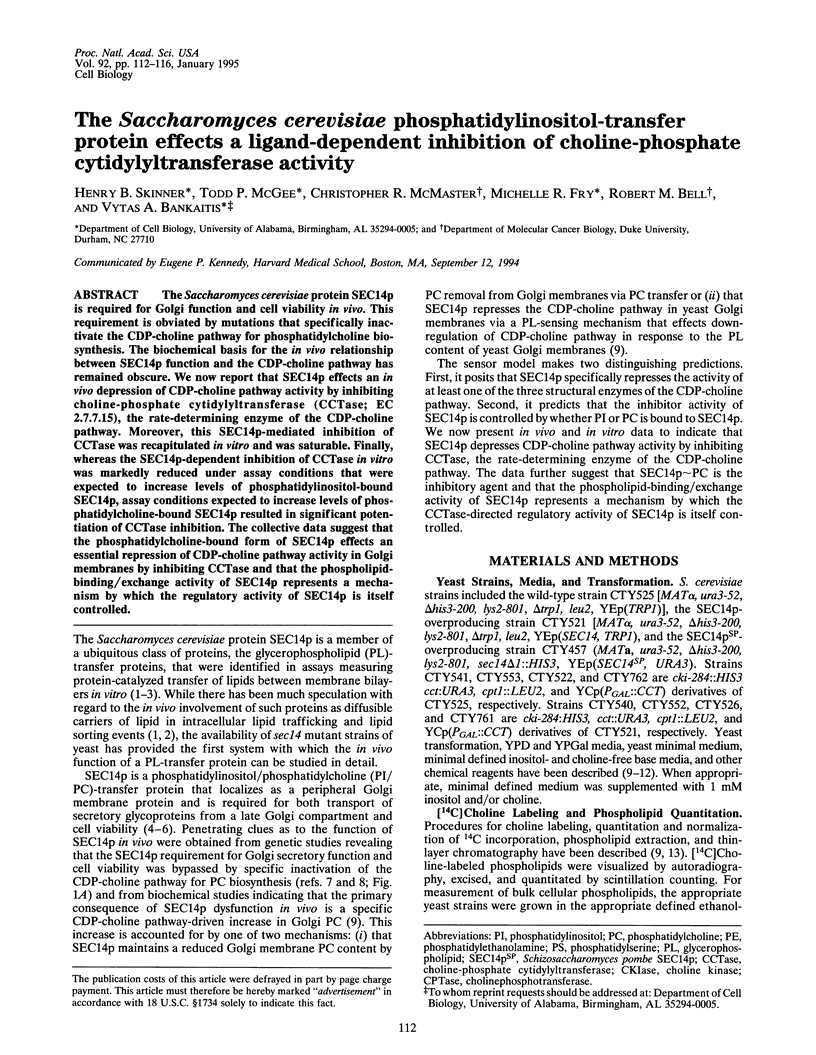
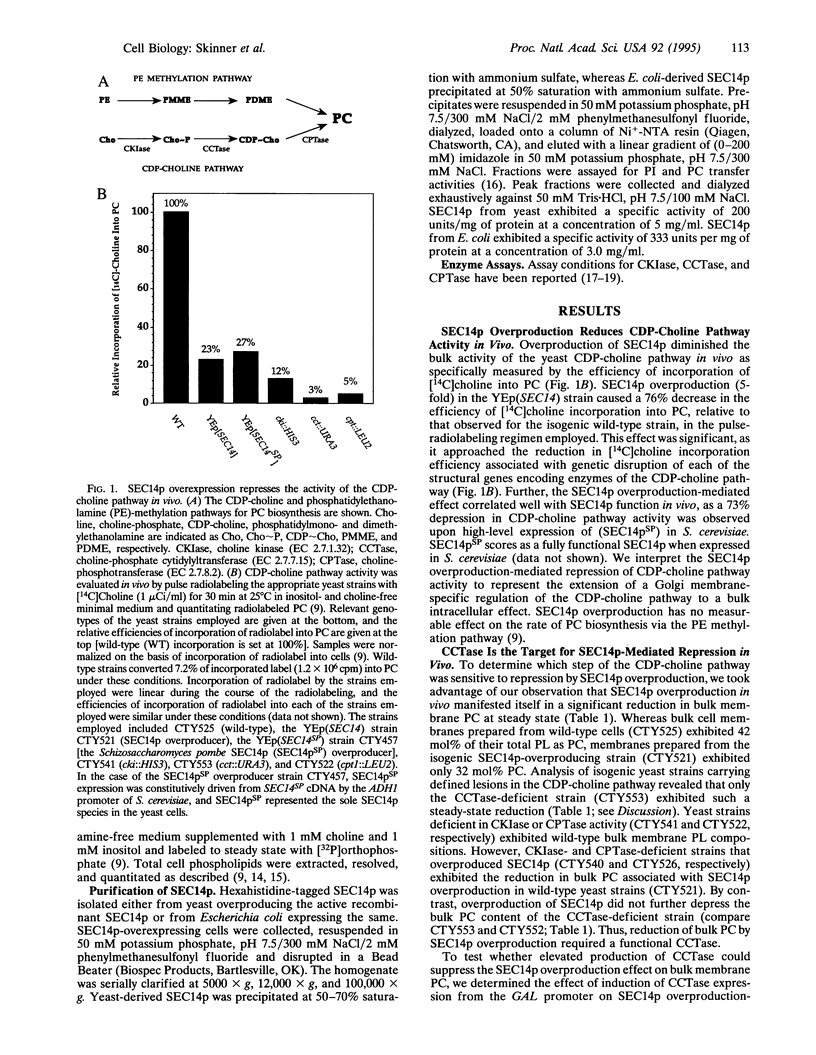
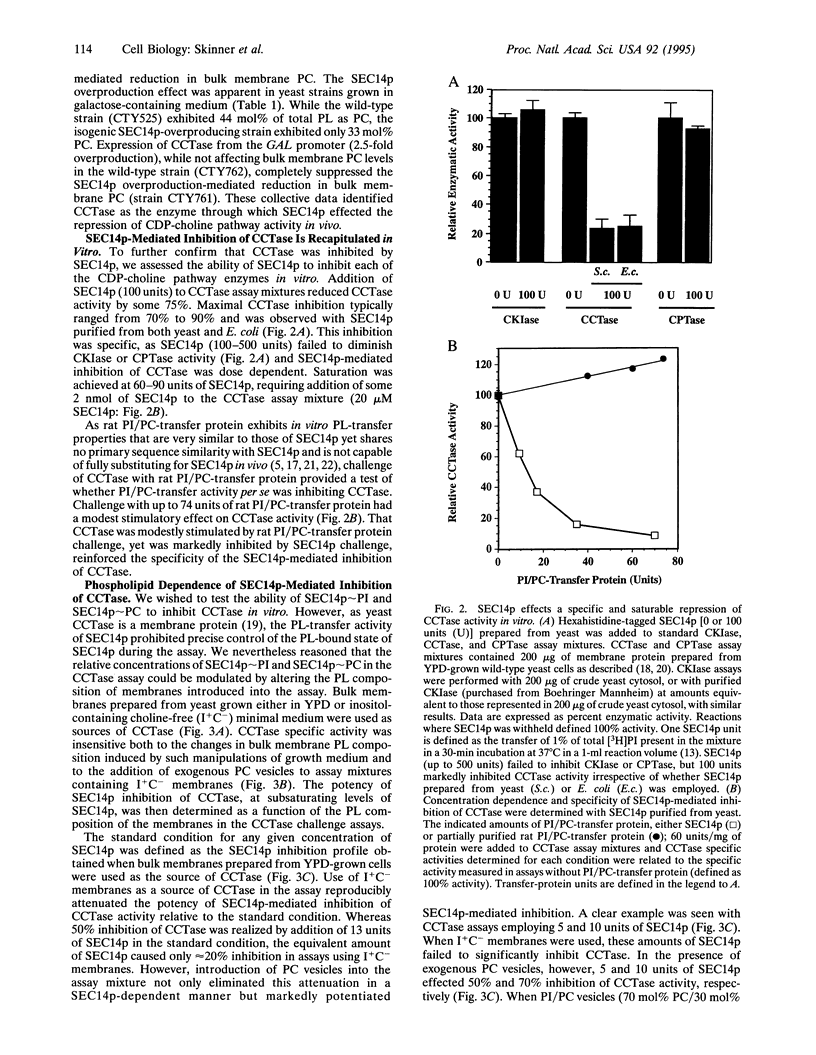
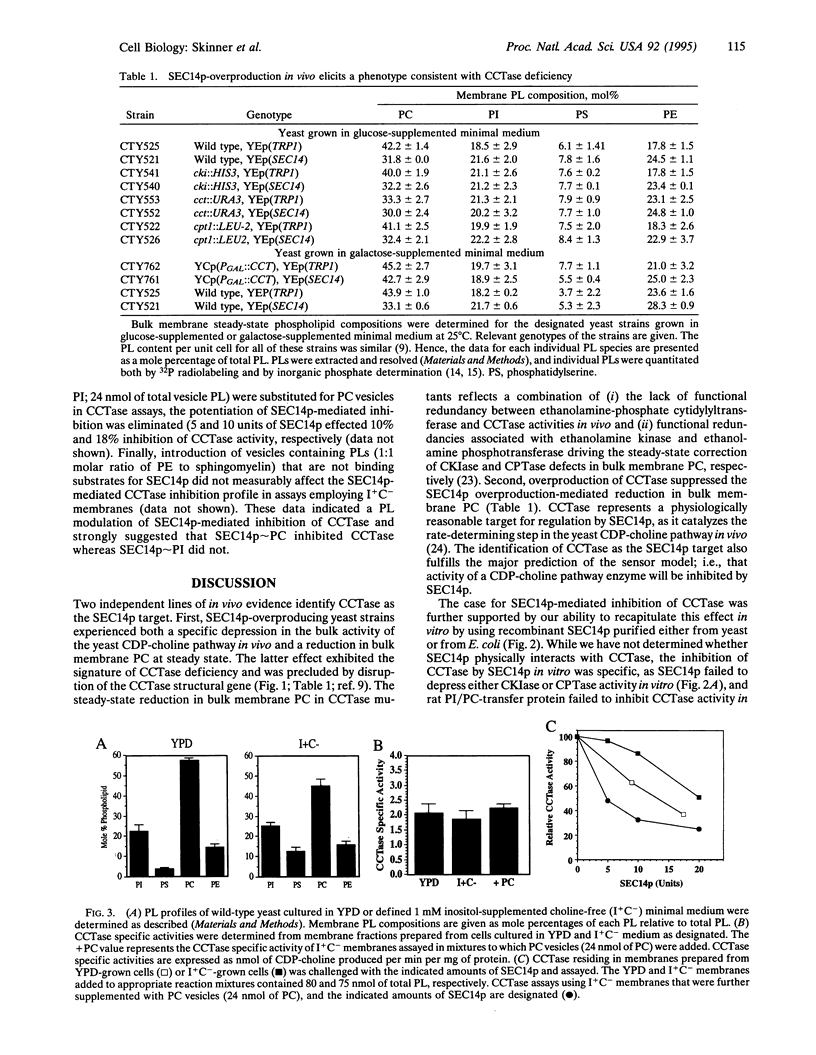
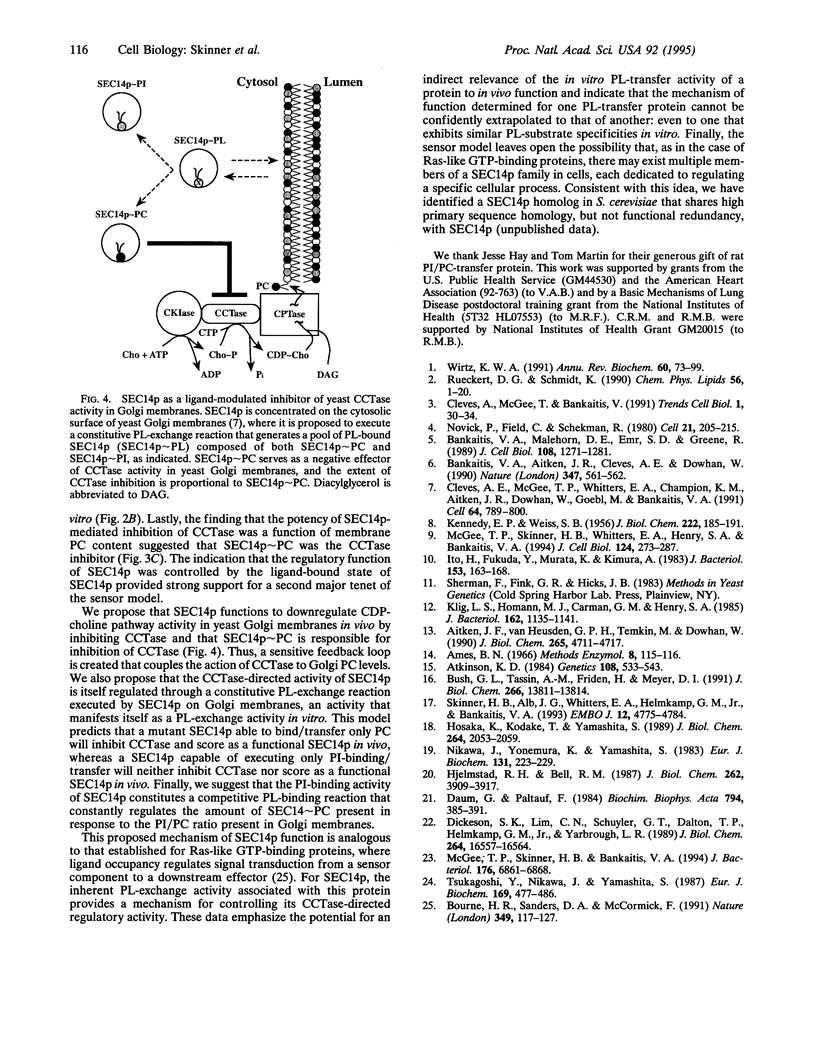
Selected References
These references are in PubMed. This may not be the complete list of references from this article.
- Aitken J. F., van Heusden G. P., Temkin M., Dowhan W. The gene encoding the phosphatidylinositol transfer protein is essential for cell growth. J Biol Chem. 1990 Mar 15;265(8):4711–4717. [PubMed] [Google Scholar]
- Atkinson K. D. SACCHAROMYCES CEREVISIAE Recessive Suppressor That Circumvents Phosphatidylserine Deficiency. Genetics. 1984 Nov;108(3):533–543. doi: 10.1093/genetics/108.3.533. [DOI] [PMC free article] [PubMed] [Google Scholar]
- Bankaitis V. A., Aitken J. R., Cleves A. E., Dowhan W. An essential role for a phospholipid transfer protein in yeast Golgi function. Nature. 1990 Oct 11;347(6293):561–562. doi: 10.1038/347561a0. [DOI] [PubMed] [Google Scholar]
- Bankaitis V. A., Malehorn D. E., Emr S. D., Greene R. The Saccharomyces cerevisiae SEC14 gene encodes a cytosolic factor that is required for transport of secretory proteins from the yeast Golgi complex. J Cell Biol. 1989 Apr;108(4):1271–1281. doi: 10.1083/jcb.108.4.1271. [DOI] [PMC free article] [PubMed] [Google Scholar]
- Bourne H. R., Sanders D. A., McCormick F. The GTPase superfamily: conserved structure and molecular mechanism. Nature. 1991 Jan 10;349(6305):117–127. doi: 10.1038/349117a0. [DOI] [PubMed] [Google Scholar]
- Bush G. L., Tassin A. M., Fridén H., Meyer D. I. Secretion in yeast. Purification and in vitro translocation of chemical amounts of prepro-alpha-factor. J Biol Chem. 1991 Jul 25;266(21):13811–13814. [PubMed] [Google Scholar]
- Cleves A. E., McGee T. P., Whitters E. A., Champion K. M., Aitken J. R., Dowhan W., Goebl M., Bankaitis V. A. Mutations in the CDP-choline pathway for phospholipid biosynthesis bypass the requirement for an essential phospholipid transfer protein. Cell. 1991 Feb 22;64(4):789–800. doi: 10.1016/0092-8674(91)90508-v. [DOI] [PMC free article] [PubMed] [Google Scholar]
- Cleves A., McGee T., Bankaitis V. Phospholipid transfer proteins: a biological debut. Trends Cell Biol. 1991 Jul;1(1):30–34. doi: 10.1016/0962-8924(91)90067-j. [DOI] [PubMed] [Google Scholar]
- Dickeson S. K., Lim C. N., Schuyler G. T., Dalton T. P., Helmkamp G. M., Jr, Yarbrough L. R. Isolation and sequence of cDNA clones encoding rat phosphatidylinositol transfer protein. J Biol Chem. 1989 Oct 5;264(28):16557–16564. [PubMed] [Google Scholar]
- Hjelmstad R. H., Bell R. M. Mutants of Saccharomyces cerevisiae defective in sn-1,2-diacylglycerol cholinephosphotransferase. Isolation, characterization, and cloning of the CPT1 gene. J Biol Chem. 1987 Mar 15;262(8):3909–3917. [PubMed] [Google Scholar]
- Hosaka K., Kodaki T., Yamashita S. Cloning and characterization of the yeast CKI gene encoding choline kinase and its expression in Escherichia coli. J Biol Chem. 1989 Feb 5;264(4):2053–2059. [PubMed] [Google Scholar]
- Ito H., Fukuda Y., Murata K., Kimura A. Transformation of intact yeast cells treated with alkali cations. J Bacteriol. 1983 Jan;153(1):163–168. doi: 10.1128/jb.153.1.163-168.1983. [DOI] [PMC free article] [PubMed] [Google Scholar]
- KENNEDY E. P. The synthesis of cytidine diphosphate choline, cytidine diphosphate ethanolamine, and related compounds. J Biol Chem. 1956 Sep;222(1):185–191. [PubMed] [Google Scholar]
- Klig L. S., Homann M. J., Carman G. M., Henry S. A. Coordinate regulation of phospholipid biosynthesis in Saccharomyces cerevisiae: pleiotropically constitutive opi1 mutant. J Bacteriol. 1985 Jun;162(3):1135–1141. doi: 10.1128/jb.162.3.1135-1141.1985. [DOI] [PMC free article] [PubMed] [Google Scholar]
- McGee T. P., Skinner H. B., Bankaitis V. A. Functional redundancy of CDP-ethanolamine and CDP-choline pathway enzymes in phospholipid biosynthesis: ethanolamine-dependent effects on steady-state membrane phospholipid composition in Saccharomyces cerevisiae. J Bacteriol. 1994 Nov;176(22):6861–6868. doi: 10.1128/jb.176.22.6861-6868.1994. [DOI] [PMC free article] [PubMed] [Google Scholar]
- McGee T. P., Skinner H. B., Whitters E. A., Henry S. A., Bankaitis V. A. A phosphatidylinositol transfer protein controls the phosphatidylcholine content of yeast Golgi membranes. J Cell Biol. 1994 Feb;124(3):273–287. doi: 10.1083/jcb.124.3.273. [DOI] [PMC free article] [PubMed] [Google Scholar]
- Nikawa J., Yonemura K., Yamashita S. Yeast mutant with thermolabile CDP-choline synthesis. Isolation and characterization of a cholinephosphate cytidyltransferase mutant. Eur J Biochem. 1983 Mar 1;131(1):223–229. doi: 10.1111/j.1432-1033.1983.tb07253.x. [DOI] [PubMed] [Google Scholar]
- Novick P., Field C., Schekman R. Identification of 23 complementation groups required for post-translational events in the yeast secretory pathway. Cell. 1980 Aug;21(1):205–215. doi: 10.1016/0092-8674(80)90128-2. [DOI] [PubMed] [Google Scholar]
- Rueckert D. G., Schmidt K. Lipid transfer proteins. Chem Phys Lipids. 1990 Nov;56(1):1–20. doi: 10.1016/0009-3084(90)90083-4. [DOI] [PubMed] [Google Scholar]
- Skinner H. B., Alb J. G., Jr, Whitters E. A., Helmkamp G. M., Jr, Bankaitis V. A. Phospholipid transfer activity is relevant to but not sufficient for the essential function of the yeast SEC14 gene product. EMBO J. 1993 Dec;12(12):4775–4784. doi: 10.1002/j.1460-2075.1993.tb06166.x. [DOI] [PMC free article] [PubMed] [Google Scholar]
- Tsukagoshi Y., Nikawa J., Yamashita S. Molecular cloning and characterization of the gene encoding cholinephosphate cytidylyltransferase in Saccharomyces cerevisiae. Eur J Biochem. 1987 Dec 15;169(3):477–486. doi: 10.1111/j.1432-1033.1987.tb13635.x. [DOI] [PubMed] [Google Scholar]
- Wirtz K. W. Phospholipid transfer proteins. Annu Rev Biochem. 1991;60:73–99. doi: 10.1146/annurev.bi.60.070191.000445. [DOI] [PubMed] [Google Scholar]


